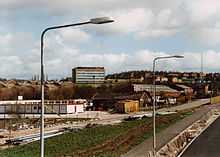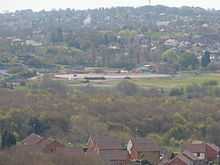Longton High School
 Box Lane, the final site of the school between 1963 and 2010 | |
| Motto | Renascor (I am born again)[1] |
|---|---|
| Established | 1760[1] |
| Closed | 2010 |
| Type |
Comprehensive community school[2] Grammar school prior to 1970 |
| Specialism | 2008–2010 Arts College |
| Location |
Box Lane Meir Staffordshire ST3 5PR England Coordinates: 52°58′56″N 2°06′32″W / 52.9822°N 2.1088°W |
| Local authority | Stoke on Trent |
| DfE number | ???/4040 |
| DfE URN | 124386 Tables |
| Ofsted | Reports |
| Gender | Co-educational |
| Ages | 11–16 |
| Houses |
Astbury Brindley Bennett Mitchell Lodge Wedgwood |
Longton High School was a school in Longton and later Meir, Staffordshire from 1760 to 2010.
History
The school was founded in 1760 with an endowment from John Bourne and was known as the Longton Free School.[3] By 1763, enough money had been provided for the purchase of land and the construction of a school building,[3] on land near to St John's church in Longton.[4] In the 1820s, the trustees decided to merge the school with the nearby St John's national school and the school lost its separate identity for some years.[3] The national school closed some time between 1859 and 1872[3] and the trustees of the Bourne estate decided to recreate the free school as a secondary school. The Endowed Schools Act 1869 enabled the trustees to sell the old property and in 1885 a new school was built in Trentham Road, Longton.[4] Management of the school passed in 1900 from the trustees to Longton Borough Council,[3] who placed it under the control of the headmaster of the nearby Sutherland Institute.[5][3]
Now known as Longton High School, the school specialised as a science school supporting the local pottery industry, and for the first time since the national school days it was co-educational and admitted both girls and boys.[3]
Up to the early 1930s, the school remained co-educational, and, together with Hanley High School, was one of two high schools in the Stoke-on-Trent area. When Brownhills Girls High School opened in the early 1930s and Thistley Hough Girls High School opened in 1938, Longton High School no longer took in girls.[6] It was run by the City of Stoke on Trent Education Committee and had around 700 boys with a three-form entry. Having outgrown the Trentham Road site, new premises were needed and in 1940 construction of a new building at Sandon Road, Meir was commenced.[4] Due to the Second World War, the school did not move into the new premises until 1947 as the new buildings had been requisitioned.[4]
In 1963, the school moved from Sandon Road in Meir to a site in Box Lane, and took in girls in the first year as a co-educational 11–18 grammar school.[7][8]
Comprehensive
It became a comprehensive in September 1970, with an age range of 12–16. From April 1974 until 1997, it was administered by Staffordshire Education Committee.
The school gained specialist Arts College status in 2007.[9] In this time it was known as Longton High School and Arts College.
Closure

To mark the closing of the school in 2010, a time capsule was buried.[7][8] The students were transferred to Sandon Business and Enterprise College.[10][11] (Sandon High School was established in the Sandon Road site when Longton High moved to Box lane.) Following the closure, the site was used by Sandon Business and Enterprise College until July 2011. On 18 December 2011, the main building was demolished[12] and the rest of the site, except for the newish technology block, was cleared early in 2012.
Houses
The houses were called Astbury, Brindley, Bennett, Mitchell, Lodge, and Wedgwood, after notable local people, and a stained glass window depicting them was a feature at both the Sandon Road and Box Lane sites.[7]
Former teachers
- Sir Emrys Evans, Vice-Chancellor from 1933-5, 1941-4, 1948–50, and from 1954-6 of the University of Wales (taught Classics from 1918-9)
Notable alumni
Boys' grammar school
- Norman Astbury CBE, Director from 1960-73 of the British Ceramic Research Association, and President from 1969-70 of the British Ceramic Society
- William Astbury, physicist and molecular biologist, Professor of Biomolecular Structure from 1945-61 at the University of Leeds
- Prof Geoffrey Boulton OBE, Regius Professor of Geology and Mineralogy from 1986-2008 at the University of Edinburgh[13]
- Cliff Brittle, Chairman from 1996-8 of the Rugby Football Union[14]
- Sir Arthur Bryan, Managing Director from 1963-85 (and Chairman from 1968-86) of Wedgwood, Lord Lieutenant of Staffordshire from 1968–93, and President from 1970-1 of the British Ceramic Manufacturers' Federation[15]
- Air Commodore Jack Frost[16]
- Prof John L. Jinks CBE, Professor of Genetics from 1985-7 at the University of Birmingham, President from 1981-4 of the Genetical Society of Great Britain (now The Genetics Society), who discovered that in-bred plants could be as good as those produced by hybrid vigour[17]
- Raymond Thompson CBE, chemist
- Prof Charles Tomlinson, poet,[18] Professor of English from 1982-92 at the University of Bristol
Later co-educational grammar school
- Robbie Earle, footballer[8]
- David Kidney, Labour MP from 1997-2010 for Stafford
- Steve Platt, Editor from 1991-6 of the New Statesman
References
- ↑ 1.0 1.1 Rees, William D. (21 July 2010). "Sonnet for Longton High School". The Sentinel. This is Staffordshire. Retrieved 29 October 2010.
- ↑ Trilling, Daniel (21 May 2009). "Just the sort of place the BNP loves". New Statesman. Retrieved 29 October 2010.
- ↑ 3.0 3.1 3.2 3.3 3.4 3.5 3.6 J. G. Jenkins, ed. (1963). The city of Stoke-on-Trent: Schools. A history of the county of Stafford 8. Victoria County History. p. 307.
- ↑ 4.0 4.1 4.2 4.3 Malkin, Neville (1976). A Grand Tour: A personal view of the Potteries. Madeley Heath: Ironmarket Press. p. 171. ISBN 0-905680-00-6.
- ↑ Green, Ken (March 2001). "A Life in the Ceramic Tile Industry, section 4". Memories of Stoke-on-Trent people. thepotteries.org. Retrieved 29 October 2010.
- ↑ Green, Ken (March 2001). "A Life in the Ceramic Tile Industry". Memories of Stoke-on-Trent people. thepotteries.org. Retrieved 29 October 2010.
- ↑ 7.0 7.1 7.2 "School memories celebrated as Longton High closes". Stoke and Staffordshire. BBC. 16 July 2010. Retrieved 29 October 2010.
- ↑ 8.0 8.1 8.2 Truswell, James; Ault, Richard (16 July 2010). "Pupils make history as Longton High School prepares to close". The Sentinel. This is Staffordshire. Retrieved 29 October 2010.
- ↑ "Happy Birthday!" (pdf). Longton High School & Specialist Arts College News. Longton High School. Autumn 2008. Retrieved 29 October 2010.
- ↑ "£17m flagship school fails Ofsted inspection". The Sentinel. This is Staffordshire. 8 December 2008. Retrieved 29 October 2010.
- ↑ "Improving Learning Improving Lives". Education. Stoke-on-Trent City Council. Retrieved 3 August 2010.
- ↑ "Ex-Longton High School block demolished". BBC News (BBC). 19 December 2011. Retrieved 21 December 2011.
- ↑ "Keele University Awards Honorary Degrees". Keele University. 2 July 2007.
- ↑ "Former RFU Chairman Cliff Brittle dies". Rugby Football Union. 14 September 2011. Retrieved 3 July 2013.
- ↑ "Sir Arthur Bryan". Daily Telegraph. 7 March 2011. Retrieved 4 July 2013.
- ↑ "Air Commodore 'Jack' Frost". Daily Telegraph. 3 October 2010. Retrieved 3 July 2013.
- ↑ Mather, K. (1988). "John Leonard Jinks. 21 October 1929-6 June 1987". Biographical Memoirs of Fellows of the Royal Society 34: 322–326. doi:10.1098/rsbm.1988.0012. JSTOR 770055. PMID 11616112.
- ↑ Ousby, Ian (1993). The Cambridge guide to literature in English, page 947. Cambridge University Press. Retrieved 29 October 2010.